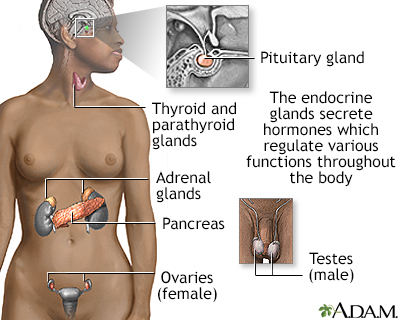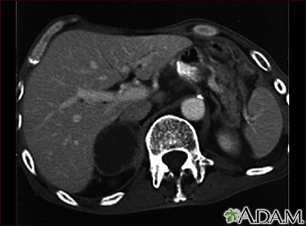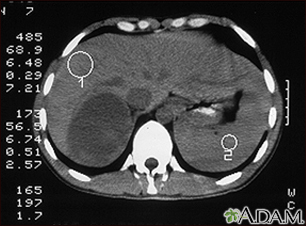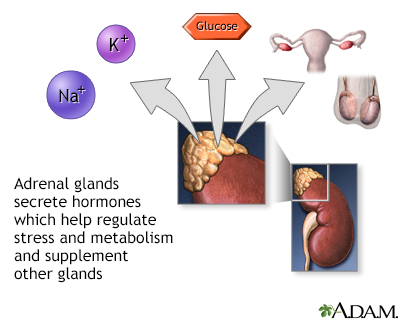Pheochromocytoma
Definition
Pheochromocytoma is a rare tumor of adrenal gland tissue. It results in the release of too much epinephrine and norepinephrine, hormones that control heart rate, metabolism, and blood pressure.
Alternative Names
Chromaffin tumors; Paraganglionoma
Causes
Pheochromocytoma may occur as a single tumor or as more than one growth. It usually develops in the center (medulla) of one or both adrenal glands. The adrenal glands are two triangle-shaped glands. One gland is located on top of each kidney. In rare cases, a pheochromocytoma occurs outside the adrenal gland. When it does, it is usually somewhere else in the abdomen.
Very few pheochromocytomas are cancerous.
The tumors may occur at any age, but they are most common from early to mid-adulthood.
In few instances, the condition may also be seen among family members (hereditary).
Symptoms
Most people with this tumor have attacks of a set of symptoms, which happen when the tumor releases hormones. The attacks usually last from a few minutes to hours. The set of symptoms include:
- Headaches
- Heart palpitations
- Sweating
- High blood pressure
As the tumor grows, the attacks often increase in frequency, length, and severity.
Other symptoms that may occur include:
Exams and Tests
The health care provider will perform a physical exam. You'll be asked about your medical history and symptoms.
Tests done may include:
- Abdominal CT scan
- Adrenal biopsy
- Catecholamines blood test (serum catecholamines)
- Glucose test
- Metanephrine blood test (serum metanephrine)
- An imaging test called an MIBG scintiscan
- MRI of abdomen
- Urine catecholamines
- Urine metanephrines
- PET scan of abdomen
Treatment
Treatment involves removing the tumor with surgery. It is important to stabilize your blood pressure and pulse with certain medicines before surgery. You may need to stay in the hospital and have your vital signs closely monitored around the time of surgery. After surgery, your vital signs will be continuously monitored in an intensive care unit.
When the tumor cannot be surgically removed, you will need to take medicine to manage it. A combination of medicines is usually needed to control the effects of the extra hormones. Radiation therapy and chemotherapy have not been effective in curing this kind of tumor.
Outlook (Prognosis)
Most people who have noncancerous tumors that are removed with surgery are still alive after 5 years. The tumors come back in some people. Levels of the hormones norepinephrine and epinephrine return to normal after surgery.
Continued high blood pressure may occur after surgery. Standard treatments can usually control the high blood pressure.
People who have been successfully treated for pheochromocytoma should have testing from time to time to make sure the tumor has not returned. Close family members may also benefit from testing, because some cases are inherited.
When to Contact a Medical Professional
Contact your provider if you:
- Have symptoms of pheochromocytoma, such as headache, sweating, and palpitations
- Had a pheochromocytoma in the past and your symptoms return
Gallery




References
Brigode WM, Miraflor EJ, Palmer BJA. The management of pheochromocytoma. In: Cameron AM, Cameron JL, eds. Current Surgical Therapy. 13th ed. Philadelphia, PA: Elsevier; 2020:750-756.
National Cancer Institute website. Pheochromocytoma and paraganglioma treatment (PDQ) - health professional version. Cancer.gov. www.cancer.gov/types/pheochromocytoma/hp/pheochromocytoma-treatment-pdq#link/_38_toc. Updated August 25, 2022. Accessed October 13, 2022.
Pacak K, Timmers HJLM, Eisenhofer G. Pheochromocytoma. In: Jameson JL, De Groot LJ, de Kretser DM, et al, eds. Endocrinology: Adult and Pediatric.7th ed. Philadelphia, PA: Elsevier Saunders; 2016:chap 110.
